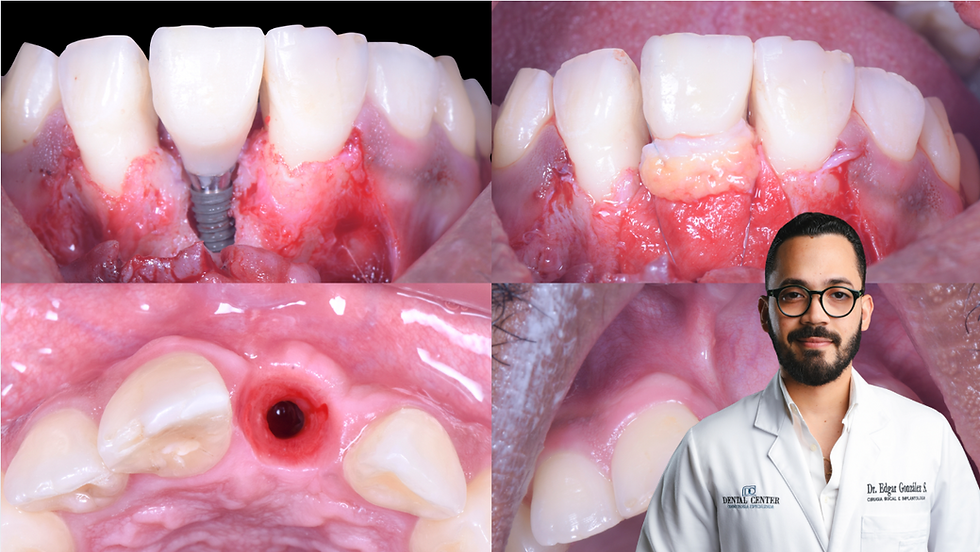Crestal and Lateral Sinus Bone Elevation with SCA and SLA Techniques
- Dr. YoungKu Heo

- Jun 28, 2018
- 3 min read
Situation A 67-year-old male. No significant medical history, except for allergic reaction to penicillin.

Panoramic view. Severe vertical bone loss at the right posterior maxilla and missing teeth at the left posterior maxilla showing about 4-5mm residual bone around the area are observed.

Clinical photograph of right posterior maxilla before the extraction. Severe bone resorption and mucosal retraction is observed.

Immediately after the extraction. The residual granulation tissue inside the extraction socket should be thoroughly irrigated and left to heal for rapid healing and preservation of the soft tissue.

Clinical photograph of the occlusal surface of left posterior maxilla showing sufficient keratinized gingiva before the surgery

Soft tissue on the planned implant site of #24, 25, and 26 has been removed using a tissue punch.

The S-reamer of the SCA Kit was used with the 4mm stopper as the expected residual bone was 4-5mm until the sinus floor opened.

The sinus floor was preopened using the 3.2mm S-reamer.

The aqua tap was used in order to elevate the sinus membrane using hydraulic pressure. The tapered tap allows itself to perform self- tapping as it has the threads at the tip.

Syringe is connected to the aqua tap and inserts water with pressure. High pressure and leakage of the water coming out from the sinus is recommended and safe. With this technique, the control of the amount of water inserted is unnecessary.

CalporeⓇ (β-TCP 60% + HAP 40%) was grafted inside the lifted space using the bone carrier.

Periapical radiograph taken after the bone graft of #25, and 26. The grafted material is clearly observed as a dome shape.

Neobiotech CMI IS II active 5.5X8.5mm fixture was placed.

Clinical photograph after the implant placement of #24, 25, and 26. Fixtures of 4.5X11.5mm, 5.5X8mm, and 5.5X8mm were placed sequentially.

Clinical photograph after connecting the healing abutments.

Panoramic photograph after the sinus floor elevation and implant placement at the left posterior maxilla. Radiopaque graft material is placed at the periapical side of the fixtures.

CT views showing #24 fixture is placed well inside the maxilla (Class I CMI fixation) right after the surgery. CT views of #25 after the implant placement show the graft material surrounding the fixture (Class II CM fixation). CT views of #26 after the implant placement show the graft material surrounding the fixture (Class II CM fixation).

Extraction socket of #14 and 15 after the extraction.

After an extensive incision, the flap was retracted.

Lateral approach using the LS-reamer was performed with the combination of 2mm stopper in the Sinus All kit . Drilling was performed at 2000 rpm with irrigation.

The LS-reamer with 3mm stopper made a thin bone disk on the membrane. The central tip does not damage the membrane.

Careful detachment of the membrane while touching and feeling the inner sinus bony wall using the elevator of the Sinus All kit.

Sinus membrane is fully detached at the lower part without perforation. The movement of the sinus membrane can be observed with the patient’s breathing.

Mixed graft material was inserted inside the sinus cavity.

IS II active 4.5x10mm fixture is placed.

IS II active 5.0x8.5mm, 4.5x10mm, and 4.5x10mm fixtures were placed respectively. Thread at the top of the fixture is exposed due to severe vertical bone loss.

Healing abutment is connected on #14 and 15 implants, and the #16 implant was planned to be submerged. The graft material (RegenOss) was placed around the exposed threads after connecting the cover screw.

A resorbable collagen membrane is placed over the graft material.

Simple interrupted sutures were performed.

Panoramic view after the surgery. The graft material inside the right sinus is shown radiopaque as an oval shape.
Meanwhile graft materials in the left sinus are well maintained.

Two months post surgery. Uncovering of implant is planned.

Four months post-surgery of the left side. Sufficient keratinized gingiva is observed.

The flap was reflected, and the bone graft around the implants is well integrated.

Healing abutment was connected and sutured.

Clinical view at stitch out.

PickCap impression copings (Neobiotech, Korea) were connected to the implants to make an impression for prosthesis fabrication.

Check the complete connection of the copings.

Other PickCap impression copings were connected at the left side.

Definitive implant prostheses were delivered.

Occlusal view of the right implant prostheses.

Occlusal view of the left implant prostheses.

Clinical photograph at the right buccal view in occlusion.

Clinical photograph at the left buccal view in occlusion.

Periapical x-ray after delivery of the definitive prosthesis (Right side).

Periapical x-ray after delivery of the definitive prosthesis (Left side).

Panoramic view after implant prosthesis delivery shows the maintenance of grafted materials.

3 year follow-up panoramic view shows the graft materials in the sinus and marginal bone level around the fixtures are well maintained. However, at #46 and 47, there is still on-going peri-implantitis. Those two Replace implants were placed by another clinician, and the prosthesis was not retrievable. Patient has refused to be treated, but treatment is necessary.



Comments